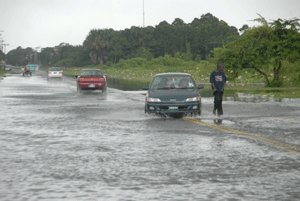SENIOR District Engineer of the Ministry of Public Works and Hydraulics, Mr. Maitland Stewart, has disclosed that
the strobe wall being built on the sea walls is costing the Ministry of Public Works $19,000 per metre of construction, whereas the use of rocks/boulders as an alternative would have cost $400,000 per metre. Stewart said that one of the initial considerations for the initiative was placing boulders about four metres out and then sloping them onto the fore-shore; but he explained that while the use of the boulders is good for breaking the wave energy, there are a lot of voids between the rocks, so when the water reaches the rocks, it dissipates almost immediately, thereby avoiding the run-up that causes the overtopping.
Stewart said that one of the initial considerations for the initiative was placing boulders about four metres out and then sloping them onto the fore-shore; but he explained that while the use of the boulders is good for breaking the wave energy, there are a lot of voids between the rocks, so when the water reaches the rocks, it dissipates almost immediately, thereby avoiding the run-up that causes the overtopping.
“A plus for us is that we noticed that the foreshore is starting to build up back…we estimate that within the next six months or so, we would have more control of this phenomenon,” Stewart noted.
He said the Works Ministry came up with the wall design for the project being done on the sea walls (a strobe wall) after studying the wave activity. “It wasn’t a case where the wave broke over the wall; it was collapsing on the wall; so we realised that building a short strobe wall (0.7 metres high) would be enough, not to completely prevent the overtopping, but to reduce that amount of overflow,” he said.
Further, the Force Account Unit, which is executing the project, intends to do a one-kilometre stretch of the strobe wall, which will extend from Liliendaal (from the Ministry of Health Building) to Conversation Tree, and even a little further up, heading to Sheriff Street.
While there have been concerns with the added weight of the strobe wall on the seawall, it was noted that several prototypes were tested and compared with the soil conditions and strength. It was then determined that a lightweight cement/concrete with an incorporation of sea shells should be used to control the weight of the structure.
Some of the other works being done in the district include maintenance and repairs to sea defences and river embankments on the coast and in riverine areas. These are also being carried out by the Force Account Unit. Additionally, continuous monitoring is done by rangers.
Meanwhile, Public Works Minister Robeson Benn said the structure being constructed is cost effective. While high tides of the magnitude that occasioned construction of the strobe wall have not recurred, the hurricane season has started, and this may cause surges in the sea that can arrive on the Guyana coast. “So we are monitoring the situation, and we are on the lookout for those, to be able to respond as much as possible,” the Minister said.
He added that as more of the wall sections go in towards the end of the new month, the sand bags will be removed from along the road.
In relation to the social gatherings on the sea wall along the Northern Carriageway, Minister Benn emphasised that there will be no liming on the seawall, because it has destroyed the embankment.
“The so-called lime will move back to the west where there is space, where there are no people living nearby, where the frolic could continue without much disturbance to the greater public,” he said.
The minister is also calling on people who are encumbering the roadside to remove their vehicles and stalls.



.jpg)









